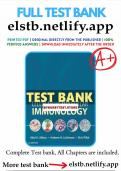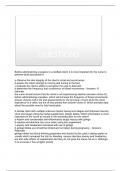Copyright © 2018, Elsevier Inc. All rights reserved. Abbas: Cellular and Molecular Immunology, 9th Edition Antibodies and Antigens Test Bank Matching Questions 1 -5 Match each of the descriptions in questions 1-5 with the correct lettered antibody isotype (A-E). (Answers may be used more than once.) A. IgA B. IgD C. IgE D. IgG E. IgM 1. The secreted form of this isotype forms pentamers around a J chain ANS: E. IgM is secreted as a J chain –linked pentamer. 2. The most abundant Ig isotype in the blood ANS: D. The blood IgG concentration is about 3.5 mg/mL and includes four subtypes (IgG1 to IgG4). 3. The isotype only found in membrane -bound form on naive B cells ANS: B. Very little IgD is secreted, and in membrane form is only on the surface of naive B cells . Its function is not well understood. 4. The isotype found predominantly in mucosal secretions ANS: A. IgA accounts for almost two thirds of the 3 g of antibody produced each day by an adult, most of which is produce d in the gastrointestinal associated lymphoid tissues and secreted into the gut lumen. 5. The isotype most closely associated with immediate hypersensitivity (allergic) disease ANS: C. Most IgE that is secreted is bound to mast cells, and it plays a role in the activation of mast cells dur ing allergic reactions. Questions 6 -10 Match each description in questions 6 -10 with the appropriate lettered term (A -I). A. Conformational determinant DOWNLOAD THE Test Bank for Cellular and Molecular Immunology 9th Edition Abbas
mynursytest.store Test Bank Copyright © 2018, Elsevier Inc. All rights reserved. 2 B. Linear determinant C. Neoantigenic determinant D. Hinge region E. Immun c omplex F. Fab G. Fc H. Tail piece I. Hapten 6. A proteolytic fragment of an antibody molecule that contains an intact antigen -
binding site ANS: F. Fab fragments, derived from enzymatic cleavage of Ig molecules, are composed of one intact light chain covalently linked to the N -terminal region of one heavy chain and include a single intact antigen -binding site. 7. A three -dimensional shape, formed by a portion of a macromolecule, to which an antibody binds ANS: A. Conformational determinants will usually be destroyed by physi cochemical disruption of macromolecules, such as by denaturation or proteolysis of proteins. 8. A small chemical group recognized by an antibody that is attached to a larger macromolecule ANS: I. Although haptens can be recognized by antibodies, they are not, by themselves, able to stimulate an antibody response (i.e., they are not immunogens). Antibody responses to haptens can be induced when the hapten is attached to a macromolecule, called a car rier. 9. The proteolytic fragment of an antibody molecule that contains the heavy chain constant region ANS: G. The Fc fragment, generated by proteolytic cleavage of an antibody molecule, is composed of the C -terminal end of the heavy chain and lacks th e antigen -binding region. This region of an intact Ig molecule, which can interact with Ig receptors and complement, is called the Fc region. 10. A region of an antibody molecule that permits bivalent binding of antibodies to pairs of surface epitopes var ying in distance from one another ANS: D. The hinge region, located between the two N -terminal Ig domains of the heavy chains of most isotypes, is flexible, permitting variations in the distance between the two antigen -binding sites. DOWNLOAD THE Test Bank for Cellular and Molecular Immunology 9th Edition Abbas
mynursytest.store Taxonomy: Recall 3. True or False? A 58-year-old man at risk of diabetes, with a sedentary lifestyle and unhealthy diet, is unwilling to follow his provider’s recommendations to modify his routine. Because he has not yet experienced the negative health consequences of his actions, he cannot be classified as resistant. Ans: False Complexity: Moderate Ahead: Interviewing Subject: Chapter 1 Title: Interview and History-Taking Strategies Taxonomy: Application 4. True or False? When taking a patient’s chief complaint, rephrase the stated reason using standard medical terminology for clarity. Ans: False Complexity: Easy Ahead: Taking a Health History Subject: Chapter 1 Title: Interview and History-Taking Strategies Taxonomy: Recall 5. True or False? Family history should include both parents and grandparents, if information is known. Ans: True Complexity: Moderate Ahead: Taking a Health History Subject: Chapter 1 Title: Interview and History-Taking Strategies Taxonomy: Application 6. True or False? Social history includes a detailed diet history, best performed as a record of food and beverage intake by the patient for a typical week, that includes things like use of salt and oil in food preparation and methods of cooking. Ans: True Complexity: Moderate Ahead: Taking a Health History Subject: Chapter 1 Title: Interview and History-Taking Strategies Taxonomy: Application Advanced Health Assessment and Diagnostic Reason ing, Third Edition
Test Bank 1. What does PQRST stand for? Ans: Precipitating factors, quality, radiation, severity, and timing
Complexity: Difficult Essay Copyright 2018 Jones & Bartlett Learning, LLC, as Ascend Learning Company ©download full chapter
bundigital.store





